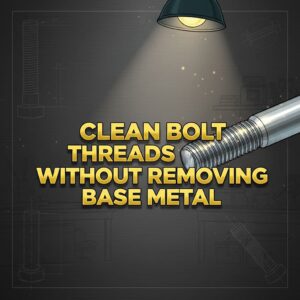👉 A look at the safest and fastest bolt thread cleaner methods for rust-damaged fasteners
Every mechanical assembly—from farm machinery to industrial automation—depends on one small but critical detail: clean, intact threads. Those threads link torque to structural reliability.
When corrosion creeps in, torque accuracy vanishes, clamping force drops, and failures follow. Cleaning isn’t cosmetic; it’s the difference between a precise joint and a broken one.
This guide teaches what to look for when restoring damaged threads and how to recognize Tier-3 quality in tools and technique—methods that deliver consistency, not guesswork.
“When corrosion creeps into a bolt’s threads, it doesn’t just look bad — it changes the way metal grips metal.”
Traditional Methods — What Works and Why
Start with chemical dissolution. For light rust, a mild acid such as white vinegar softens oxidation without removing base metal. Check that the soak container is non-reactive and ventilated. For heavy corrosion, a small salt addition accelerates reaction—but always neutralize afterward.
Look for controlled chemistry. If using commercial rust removers, confirm they contain phosphoric or chelating agents and follow the manufacturer’s dwell times precisely. Tier-3 practice means knowing when to stop, not how long to wait.
Once loosened, clear the root. That’s where the load travels. A stiff wire brush should reach into the thread groove, working both along and across the helix. Avoid powered wire wheels on precision fasteners—they cut, deform, and compromise fit.
Restore the form, not just the shine. Choose a thread-chasing die, not a cutting die. A chasing die reforms minor distortion and ejects debris without stealing base metal. That’s the mark of professional restoration: geometry preserved, not replaced.
Finish with neutralization and protection. After rinsing, always neutralize acids with a mild baking-soda solution. Dry completely—compressed air beats rags—and coat with light oil or anti-seize. Tier-3 discipline ends every cleaning with corrosion control, not just inspection.
Purpose-Built Thread Cleaner — The Tier-3 Method
When speed and repeatability matter, look for a dedicated thread-cleaning tool. These compact systems combine precision alignment and controlled friction inside an enclosed body.
Check for size indexing. The tool should clearly mark each opening so the bolt engages at full thread depth. Color coding—metric vs. SAE—helps prevent cross-fit mistakes in field work.
Operation is simple but deliberate. Insert the fastener into the matched opening and drive it through using a hand wrench or ratchet. The internal cleaning elements must contact the thread root evenly—this uniform pressure clears debris without shaving steel.

Evaluate containment and safety. Tier-3 tools trap debris inside the housing, keeping the bench clean and eliminating airborne rust. This protects both worker and workspace—critical for shops with mixed materials or electronics nearby.
Know its limits. These tools restore, not rebuild. Severely stripped or pitted threads still require replacement. A Tier-3 technician knows when to stop cleaning and start sourcing new hardware.
Field Experience — Huguenot, N.Y.
A few years back, I got a call from a large OEM in Huguenot, New York—a manufacturer of heavy-duty industrial batteries for forklifts and other equipment. The acid mist inside that plant was brutal on metal.
They were mid-rebuild under a tight deadline. Specialized fasteners had to be reused; new stock wasn’t on hand. A hundred bolts sat rusted on the bench while techs attacked them with wire brushes and solvent cans.
That’s usually when I get the call.
“Got anything that makes this part easier?”
There’s no miracle cure, but there are smarter options. I introduced them to the purpose-built thread-cleaning tool described here. It cleared corrosion quickly without cutting the base metal. Every bolt came out clean, smooth, and ready for torque.
For large rebuilds, that efficiency isn’t luxury—it’s survival. Tools like that save time, save hands, and save the entire afternoon.
Putting It All Together
Clean threads are precision’s foundation. Whether restored manually or with a specialized cleaner, the goal never changes: correct fit, true torque, and repeatable performance.
Choose your method by scope. A handful of bolts might only need brush and solvent. Full rebuilds demand repeatable systems that preserve form and shorten cycle time.
Evaluate every method the same way:
- Does it remove contamination without removing metal?
- Does it protect threads after cleaning?
- Can it be repeated safely and consistently?
Those three questions separate Tier-1 improvisation from Tier-3 craftsmanship.
Final Thought
Thread maintenance is not an afterthought. It’s the quiet discipline behind every safe repair and every reliable machine.
The technician doesn’t chase brands; they chase repeatability. They know what to look for, how to verify it, and when to trust the metal again.
That’s how experience turns into authority—one cleaned bolt at a time.


